Podcast
Questions and Answers
What is the primary consequence of arteriolosclerosis and Mönckeberg medial calcific sclerosis?
What is the primary consequence of arteriolosclerosis and Mönckeberg medial calcific sclerosis?
- Acute coronary syndromes
- Chronic ischemic heart disease
- Vascular thrombosis
- Downstream ischemic injury (correct)
What is the composition of the core of an atheromatous plaque?
What is the composition of the core of an atheromatous plaque?
- Calcific deposits and bone tissue
- Fibrous tissue and smooth muscle cells
- Lipid, mainly cholesterol and cholesterol esters (correct)
- Inflammatory cells and collagen
What percentage of cardiovascular events occur in the absence of traditional risk factors?
What percentage of cardiovascular events occur in the absence of traditional risk factors?
- 10%
- 25%
- 20% (correct)
- 15%
Which of the following is a non-modifiable risk factor for atherosclerosis?
Which of the following is a non-modifiable risk factor for atherosclerosis?
What is the term for the hardening of the arteries characterized by intimal lesions called atheromas?
What is the term for the hardening of the arteries characterized by intimal lesions called atheromas?
What is the critical percentage of fixed occlusion in coronary arteries that significantly limits flow and causes demand to exceed supply?
What is the critical percentage of fixed occlusion in coronary arteries that significantly limits flow and causes demand to exceed supply?
What is the consequence of atherosclerotic plaque rupture in a vessel?
What is the consequence of atherosclerotic plaque rupture in a vessel?
What is the term for diminished extremity perfusion due to atherosclerotic stenosis?
What is the term for diminished extremity perfusion due to atherosclerotic stenosis?
What is the result of hemorrhage into the atheroma?
What is the result of hemorrhage into the atheroma?
What is the term for a condition where demand exceeds supply due to atherosclerotic stenosis in the coronary circulation?
What is the term for a condition where demand exceeds supply due to atherosclerotic stenosis in the coronary circulation?
What is a characteristic of luminal obstruction in other coronary syndromes, besides acute coronary syndromes?
What is a characteristic of luminal obstruction in other coronary syndromes, besides acute coronary syndromes?
Which of the following is NOT a stimulator of vasoconstriction at sites of atheroma?
Which of the following is NOT a stimulator of vasoconstriction at sites of atheroma?
What is the result of impaired secretion of endothelial cell relaxing factors relative to contracting factors in atherosclerosis?
What is the result of impaired secretion of endothelial cell relaxing factors relative to contracting factors in atherosclerosis?
Which of the following is a microscopic feature of fibroinflammatory lipid plaque?
Which of the following is a microscopic feature of fibroinflammatory lipid plaque?
What is a key component of the management of dyslipidemia?
What is a key component of the management of dyslipidemia?
Flashcards are hidden until you start studying
Study Notes
Atherosclerosis
- Atherosclerosis often involves arteries supplying the heart, brain, kidneys, and lower extremities
- Major consequences of atherosclerosis include myocardial infarction (heart attack), cerebral infarction (stroke), aortic aneurysms, and peripheral vascular disease (gangrene of the legs)
Pathological Consequences
- Smaller vessels can become occluded, compromising distal tissue perfusion
- Ruptured plaque can embolize atherosclerotic debris and cause distal vessel obstruction or lead to acute vascular thrombosis
- Destruction of the underlying vessel wall can lead to aneurysm formation, with secondary rupture and/or thrombosis
Atherosclerotic Stenosis
- Atherosclerotic plaques can gradually occlude vessel lumens, compromising blood flow and causing ischemic injury
- Critical stenosis occurs when chronic occlusion significantly limits flow, and demand begins exceeding supply (typically at approximately 70% fixed occlusion)
- Consequences of low limiting stenosis include chest pain (angina) on exertion, mesenteric occlusion and bowel ischemia, chronic IHD, ischemic encephalopathy, and intermittent claudication (diminished extremity perfusion)
Acute Plaque Change
- Plaque erosion or rupture is typically promptly followed by partial or complete vascular thrombosis, resulting in acute tissue infarction (e.g., myocardial or cerebral infarction)
- Plaque changes fall into three general categories: rupture/fissuring, erosion/ulceration, and hemorrhage into the atheroma
Vasoconstriction
- Vasoconstriction compromises lumen size and can potentiate plaque disruption
- Stimuli for vasoconstriction at sites of atheroma include circulating adrenergic agonists, locally released platelet contents, impaired secretion of endothelial cell relaxing factors, and mediators released from perivascular inflammatory cells
Treatment
- Dietary modification is an important component in the management of dyslipidemia
- Pharmacologic treatment is also available
Arteriosclerosis
- Arteriosclerosis is a generic term reflecting arterial wall thickening and loss of elasticity
- Three general patterns of arteriosclerosis include arteriolosclerosis, Mönckeberg medial calcific sclerosis, and atherosclerosis
Atherosclerosis
- Atherosclerosis is characterized by intimal lesions called atheromas (also called atheromatous or atherosclerotic plaques) that protrude into vascular lumina
- An atheromatous plaque consists of a raised lesion with a soft, yellow, grumous core of lipid covered by a firm, white fibrous cap
Epidemiology
- Atherosclerosis is virtually ubiquitous among most developed nations, but less prevalent in Central and South America, Africa, and Asia
- Multiple risk factors have a multiplicative effect; two risk factors increase the risk approximately fourfold
- Risk factors for atherosclerosis include modifiable factors (hyperlipidemia, hypertension, cigarette smoking, diabetes, and inflammation) and non-modifiable factors (increasing age, male gender, family history, and genetic abnormalities)
Studying That Suits You
Use AI to generate personalized quizzes and flashcards to suit your learning preferences.




